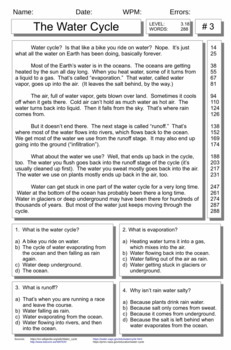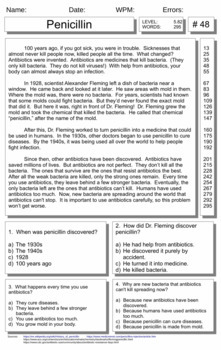50 Informational Text CBM Reading Comprehension Passages (RTI CBM Repetition)
- PDF
Description
Here are fifty reading comprehension passages. All of them are informational text. They are on a wide variety of topics (list at the end of this description).
Each one has the number of words, both total and on each line, for easy RTI/repeated reading/CBM use. There's a charting page (an enhanced version of the one I used to use). There's an organizer for main idea and details. There's pretty much everything you could want for teaching informational text. Each passage also has the Flesch-Kincaid reading level. (Passages should be usable up to one grade level below that with some vocabulary support.) Flesch-Kincaid grade levels range from 3.10 to 5.88.
This is not a book for beginning readers. This is a book for students whose reading has gotten stuck somewhere between the 2nd and 4th grade levels. Many of these passages have been used with students in that range. (Some of them are much older than 2nd to 4th grade.) Most of these were strong sight readers with no phonics; a few were the opposite. I've used many of these passages with both Special Education and ESL students. Many of them were written for a group who got nothing but worksheets, so some of the science topics were chosen with Nevada science standards in mind.
I came at this from a Special Education perspective, I am more concerned with a student's actual reading level than their grade level. That said, this book should be useful for native-English-speaking students between about grades 2 and 6, and ESL students of any age.
This book was written with repeated reading in mind. That's where you systematically have a student read passages over and over until they reach a target speed (or you give up on that passage and move on before they get too bored with it). You chart their progress and modify your instruction based on whether the trend is upward or not, and whether it's going up fast enough.
That said, it should be useful for CBM and more general RTI instruction as well.
Each passage includes four reading comprehension questions. At least one of these four questions cannot be answered by matching the question to the text itself verbatim. (While that will get you half the answers on a test, half is still failing.)
The list of topics is as follows:
Polar Bears, The Water Cycle, Comic Sans, Beef and Pork vs. Cow and Pig, Bear Safety, Plato's Cave, Noodles, The Solar System, Chuck Yeager, Fossil Fuels and Climate Change, Peppered Moths, The Pitch Drop Experiment, Containerized Shipping, Laika, The Chery QQ, Origin of the Moon, Asian Giant Hornet, The Bronze Age, Echolocation, Hip Hop, Steve Wozniak, Rabies, Easter Island, Zheng He, Vinland, Minecraft, Villa of the Papyri, The History of the Internet, Zombies, Pokemon, Vaccines, Wolves vs. Coyotes, Mustangs, Algebra, Reality Television, Atoms, The Baiji, The P51 Mustang, The Ford Mustang, Outer Space Vacuum Cleaner, The Irish Potato Famine, The Sentinelese People, Cassowaries, What Food Is Made Of, The Invention of Writing, Speed vs. Mass, Chocolate, Penicillin, Naming America, Heavy Metal Music
I've tried to maintain Neutral Point Of View, but author POV will naturally come through at times, so if you want to use these passages for that as well, it would not be inappropriate. If there's a weakness to my POV here, it's that some passages might come off as a bit Euro- and Sino-centric. I've tried to stick to phrasing that is objectively true, and I have tried to acknowledge all groups involved, but I am ultimately approaching each topic from only one perspective.
Using them solely as comprehension passages and not as a measurement tool, these passages should work as homework or literacy station material, or a worksheet for an entire class. They would also be appropriate in a home school setting. Using them for CBM/RTI/repeated reading, however, would require a one-on-one or small group setting, and would be more appropriate for a special education classroom.





